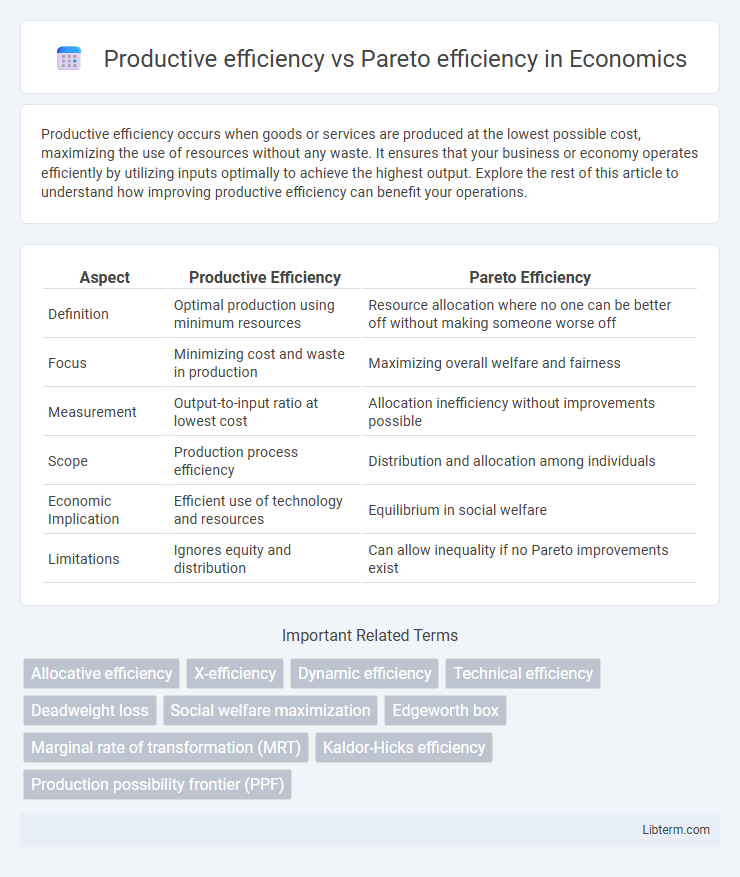Productive efficiency occurs when goods or services are produced at the lowest possible cost, maximizing the use of resources without any waste. It ensures that your business or economy operates efficiently by utilizing inputs optimally to achieve the highest output. Explore the rest of this article to understand how improving productive efficiency can benefit your operations.
Table of Comparison
| Aspect | Productive Efficiency | Pareto Efficiency |
|---|---|---|
| Definition | Optimal production using minimum resources | Resource allocation where no one can be better off without making someone worse off |
| Focus | Minimizing cost and waste in production | Maximizing overall welfare and fairness |
| Measurement | Output-to-input ratio at lowest cost | Allocation inefficiency without improvements possible |
| Scope | Production process efficiency | Distribution and allocation among individuals |
| Economic Implication | Efficient use of technology and resources | Equilibrium in social welfare |
| Limitations | Ignores equity and distribution | Can allow inequality if no Pareto improvements exist |
Understanding Productive Efficiency
Productive efficiency occurs when a firm or economy produces the maximum possible output from given resources, minimizing waste and costs. It is measured by the position on the production possibility frontier (PPF), where output cannot be increased without increasing input. Unlike Pareto efficiency, which considers optimal allocation of resources for overall welfare, productive efficiency strictly focuses on maximizing output efficiency in production processes.
Defining Pareto Efficiency
Pareto efficiency occurs when resources are allocated in a way that no individual can be made better off without making someone else worse off, representing an optimal distribution of welfare. It contrasts with productive efficiency, which focuses on producing goods at the lowest possible cost without waste. While productive efficiency ensures maximizing output with given inputs, Pareto efficiency emphasizes optimal outcomes in resource allocation without harm to any party.
Key Differences Between Productive and Pareto Efficiency
Productive efficiency occurs when goods or services are produced at the lowest possible cost, utilizing all resources fully without waste, while Pareto efficiency is achieved when no individual's situation can be improved without worsening another's. Productive efficiency focuses on minimizing input use and maximizing output within production processes, whereas Pareto efficiency assesses the allocation of resources across individuals in an economy for optimal distribution. The key difference lies in productive efficiency being a condition of cost-effective production, contrasted with Pareto efficiency being a broader concept of economic welfare and resource allocation.
Real-World Examples of Productive Efficiency
Productive efficiency occurs when goods or services are produced at the lowest possible cost, maximizing output with given inputs, as seen in manufacturing sectors like automotive production where assembly lines minimize waste and optimize resource use. In contrast, Pareto efficiency refers to an allocation where no individual can be made better off without making someone else worse off, exemplified in markets where resources are allocated without room for mutually beneficial trades. Real-world examples of productive efficiency include fast-food chains implementing standardized processes to reduce labor costs and technology firms utilizing automation to enhance software development speed and reduce errors.
Real-World Scenarios Illustrating Pareto Efficiency
Pareto efficiency in real-world scenarios is exemplified by resource allocations where no individual can be made better off without making someone else worse off, such as in housing markets or labor negotiations. Unlike productive efficiency, which emphasizes maximizing output from inputs, Pareto efficiency captures the optimal distribution of resources reflecting individual preferences and trade-offs. In practice, achieving Pareto efficiency often guides policymakers in designing welfare programs and market interventions that balance competing interests without reducing overall social welfare.
Conditions Required for Productive Efficiency
Productive efficiency occurs when goods or services are produced at the lowest possible cost, requiring optimal utilization of resources and technology. Conditions include the full employment of inputs, minimizing waste, and operating on the production possibility frontier (PPF). In contrast, Pareto efficiency involves an allocation where no individual's situation can be improved without worsening another's, focusing on resource distribution rather than cost minimization.
Achieving Pareto Efficiency in Economic Systems
Achieving Pareto efficiency in economic systems requires allocating resources so no individual can be made better off without making another worse off, contrasting with productive efficiency which focuses on maximizing output with given inputs. Economic policies aimed at Pareto improvements emphasize optimizing trade-offs and equitable distribution rather than merely minimizing production costs. Market mechanisms, combined with regulatory interventions, play crucial roles in steering economies toward Pareto-optimal outcomes.
Limitations of Productive and Pareto Efficiency
Productive efficiency is limited by its focus on the optimal use of resources to maximize output, ignoring the distribution of goods and overall welfare, which may lead to inequitable outcomes. Pareto efficiency, while accounting for allocations where no individual can be made better off without making others worse off, fails to address the magnitude of inequality or the fairness of such distributions. Both efficiencies lack mechanisms to evaluate the social desirability of the resource allocation, restricting their applicability in comprehensive economic policy decisions.
Comparing Efficiency Impacts on Resource Allocation
Productive efficiency occurs when resources are allocated to maximize output without waste, ensuring that production is at its lowest possible cost. Pareto efficiency is achieved when resources are allocated in a way that no individual's situation can be improved without worsening another's, emphasizing optimal distribution rather than just maximum output. Comparing the two, productive efficiency focuses on minimizing production costs and maximizing goods, while Pareto efficiency prioritizes equitable resource allocation that balances competing interests without diminishing overall utility.
The Role of Efficiency in Economic Policy Decisions
Productive efficiency ensures resources are used to maximize output, minimizing waste in economic systems, while Pareto efficiency focuses on allocating resources where no individual can be made better off without making another worse off. Economic policy decisions prioritize achieving productive efficiency to optimize resource utilization, but Pareto efficiency guides policies towards equitable and socially acceptable outcomes. Balancing these efficiencies helps policymakers design strategies that enhance overall welfare and sustainable growth.
Productive efficiency Infographic

 libterm.com
libterm.com